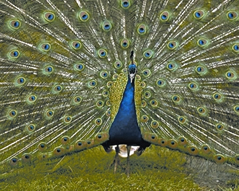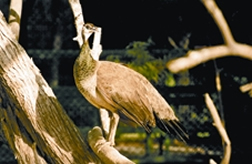Peafowl
Peafowl (mayur) pheasants of Phasianidae family. Of the three peafowl species, the Blue Peafowl or the Indian Peafowl, Pavo cristatus, have adapted easily to living with humans, not only in their native India, but also they are found in parks throughout Europe. The Green Peafowl P. muticus, is now threatened in South and Southeast Asia. JP Chapin, discovered the Congo Peafowl in 1936 in the equatorial rainforest of eastern Zaire, Central Africa. How this species became isolated from all other members of the pheasant group, which live in Asia is a real mystery. The male of the Indian Peafowl is known as peacock and the female is the peahen; collectively both are peafowl.

The male peacock has a crest and whitish bare areas on the sides of the head; the plumage is brilliant metallic green and blue. The upper tail coverts are enormously elongated, forming the train of more than a metre in length, bronzy-green and blue in colour, and ornamented with brilliantly coloured eyespots or ocelli. A white variety is common in captivity. In courtship display, the train is erected vertically above the bird's back, being supported by the tail feathers. At the climax of the display the tail feathers are vibrated, giving the feathers of the train a shimmering appearance and imparting a rustling sound.
In captivity the birds often display outside courtship periods, seemingly showing off, hence the saying, 'proud as a peacock'. Length: male 2 to 2.25 metres in full plumage; female about 86 cm. Female is similarly crested but without the sweeping train. Above, head and nape rufous-brown. Rest of upperparts brown, finally mottled paler. Below, lower neck metallic green instead of blue; breast buffy brown glossed with green; abdomen buffy white. Young (immature male) looks like adult female but with the primaries largely chestnut. During the breeding season the male utters a raucous, harsh cry. The bird is polygamous, each male seeking to acquire a harem of four or five hens. Breeding season ranges chiefly January to April, but July to September has also bee recorded. The hen lays from four to six whitish, sometimes spotted eggs in a hidden nest. Incubation by hen alone, occupying 26-28 days. The Indian Peafowl, once found around Gazipur areas even 40 years back, is now feared extinct from the country.

The related species of Indian Peafowl is Green Peafowl (P. muticus), occurs in the SE part of the country. Size is same as the Indian Peafowl. Male can be distinguished from Indian peacock by overall green colouration. Crest upstanding, pointed (not fan-like), of lanceolate shot blue-green feathers. Bare facial skin blue and yellow. Neck and breast glistening bronze-green and purple finely scalloped with black. Train more tinged with copper-bronzy violet in certain lights. Female is more or less similar to male but without train. Upper tail-coverts as long as tail, golden green cross-barred with pale rufous mottling. Dance and breeding activities are almost similar to that of Indian Peafowl.
The peacock is considered sacred in Hindu mythology as the vehicle of the god Kartika the son of Lord Shiva and his consort Parvati, and a brother of elephant-headed Ganesha. In 1963 the peacock was officially designated as the National Bird of India. The Phoenicians introduced the bird to the Pharaohs of Egypt, and Alexander the Great took it to Greece. The feathers were exported from India in quantities for ornamental use. In Rome and later in medieval Europe, peafowl were raised for table. [Md Anwarul Islam]
